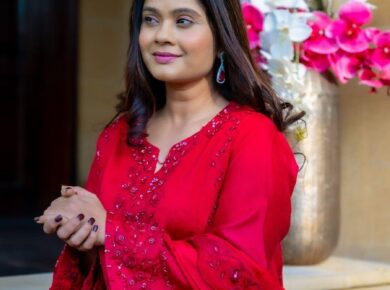Lucy Savanis: ‘We’re Over Minimalism,’ Says Designer Behind London’s Old War Office Conversion

OMG, the Old War Office in London is getting a major glow up and it’s going to be the most epic pad for residents! This iconic building was the HQ of Winston Churchill during WWII and had secret tunnels that government officials used to sneak around in. It’s even the inspiration for James Bond’s MI6 headquarters and was featured in a couple of 007 flicks.
But wait, it gets better! The Old War Office is now The OWO Residences by Raffles, with 85 fancy-schmancy apartments designed by the one and only Lucy Savanis from 1508 London. She’s combined classic and modern styles to create a totally lit living experience.
What was the biggest challenge in transforming a heritage landmark building?
Lucy Savanis: It was a bespoke approach based on both the building itself and the client’s aspirations. In terms of heritage buildings, this one has power and grandeur. It was unprecedented for us. It was a challenge. For every project, we start by researching the heritage of the building and what the site is, then the design principles guide our approach and design decisions, while putting the concepts together. We also had heritage consultants on board when we were researching the building’s design history, whether it’s the patterns on the floors or the architectural features and moldings, the doors and fireplaces, we took a note to examine every detail.
How do you work with, not against, the heritage-listed interiors at the Old War Office?
LS: Our goal was to create a unique design that will allow the legacy of the Old War Office to live on. We didn’t want to have a pastiche approach to historicism or a copy. We wanted to reinstate the original features where they were found, then create additional parts to the building which echoes the principles and proportions of the original building in a manner that didn’t copy the features. There’s a blend between old and new, but it’s legible for the keen eye to see.
Does the building feel grand when you’re in it?
LS: It is quite grand. It was a seat of power and victory, there is the feeling of grandeur and power. There’s a secret entrance to the side that people call the spy entrance, but it isn’t a secret. It’s just a little more off the main street. There are layers of important figures in this building. You realize there’s a hierarchy to each floor. The moldings are a different proportion, feeling grander. It has a palatial feeling to it, but it’s not overwhelming.
How do you manage the balance between classic and contemporary?
LS: Distilling the principles and proportions of the original areas of the building. When designing the more contemporary parts, we continued the traditions with contemporary, like the leather panels with grass details that echo the heavier timber paneling but in a fresher interpretation. There’s dialogue between past and present. We wanted walnut doors and rich paneling, cherry and walnut in the timber joinery and the doors. What was original, what was not? When it turned into an office building in the 1980s, the ceilings were dropped, there was that typical office vibe. When we started peeling off the layers, we were happy to discover these ornate orifices behind them.
What kind of marble is in the building?
LS: They used a lot of Carrara marble, we have used similar marbles in other areas, like on the ground floor’s entrance. On the grand staircase, there’s a beautiful alabaster, too. When we were sourcing different marble for the apartments, we were influenced by that aesthetic. We went with red salmon tones in the private club lounge, and we used a colorful stone that looks out to the garden. We wanted to pick up on the leafy greens and mix it up with reds and amber.

This Icehotel opens mid-December with 44 warm hotel rooms, 28 warm chalets, 18 year-round open art suites made from ice and 32 artist-designed suites made of ice from the nearby Torne River in Sweden. There are nine deluxe suites, as well. This year, the award-winning design duo Prince Carl Philip Bernadotte and Oscar Kylberg have designed a suite. “The goal is to design a room in a unique Swedish environment, on nature’s own terms,” says Kylberg, CEO of Bernadotte & Kylberg.
“All the ice comes from the river and it goes back after, like a circle,” says Luca Roncoroni, the creative director of the Icehotel in Sweden. “Knowing that you can try out a new idea next year is very liberating; it has an interesting effect on creativity.”
What is your personal definition of luxury?
LS: If I said ‘time,’ I would probably sound like everyone else. It’s definitely time to enjoy the beauty that surrounds you, whether it’s natural or manmade. I think it’s a mix of the two, time to be surrounded by beauty.
How do you preserve the history of a home?
LS: It’s important to research the story of the house, the era, what was happening at the time. Sometimes it depends where you live, but there’s always an opportunity to layer tactile elements and create a richness in your palette, whether it’s deep colors and contrasts. I think we’re over minimalism, it’s more about layered, tactile minimalism that allows you to bring a warmth to it.
Which designer helped shape your vision?
LS: Carlo Scarpa has been a great influence, just the way he has blended the old with the new, which live harmoniously together. The way he uses raw materials and lets them speak to themselves, that has been a huge inspiration.
What is your favorite design quote?
LS: I believe it was Frank Gehry who said that architecture should speak of its time and place. And that authenticity is very important. That quote has guided me through many projects. Architects don’t like designing things that pretend to be something they’re not. Just work with natural materials and let them speak for themselves, through details.
What design trends will lead in 2022?
LS: A proximity to nature and designing with nature. Using natural materials, blending the indoor outdoor. Boundaries. Nature in all its layers, bringing it in will be relevant in 2022 and moving forward as we are becoming more aware of eco-consciousness and wellness as a society. That will make it live on.





d5656
how can i get generic clomiphene no prescription can i order clomiphene without rx can i get cheap clomiphene without dr prescription can i buy generic clomid tablets buy cheap clomid without prescription where buy generic clomiphene order generic clomid without a prescription
June 7, 2025generic cialis cheap canada
More peace pieces like this would insinuate the web better.
June 10, 2025side effects cipro and flagyl
More content pieces like this would make the интернет better.
June 11, 2025ut2sk
order generic azithromycin 250mg – order metronidazole 400mg for sale order flagyl 400mg
June 13, 2025